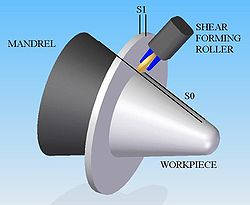
Metal spinning, also known as spin forming or spinning, is a metalworking process by which a disc or tube of metal is rotated at high speed and formed into an axially symmetric part. Spinning can be performed by hand or by a CNC lathe.
Metal spinning ranges from an artisan's specialty to the most advantageous way to form round metal parts for commercial applications. Artisans use the process to produce architectural detail, specialty lighting, decorative household goods and urns. Commercial applications include rocket nose cones, cookware, gas cylinders, brass instrument bells, and public waste receptacles. Virtually any ductile metal may be formed, from aluminum or stainless steel, to high-strength, high-temperature alloys. The diameter and depth of formed parts are limited only by the size of the equipment available.
Shear forming, also referred as shear spinning, is different from conventional metal spinning in that in this latter the area of the final component is approximately equal to that of the flat sheet metal blank and little or no reduction in the wall thickness occurs, whereas in shear forming a reduction of the wall thickness is induced. This final wall thickness is achieved by controlling the gap between the roller and the mandrel.

METAL SPINNING


SHEAR SPINNING

